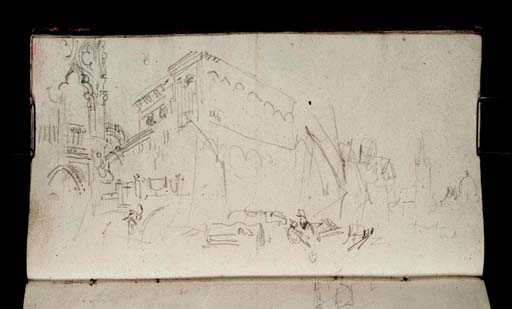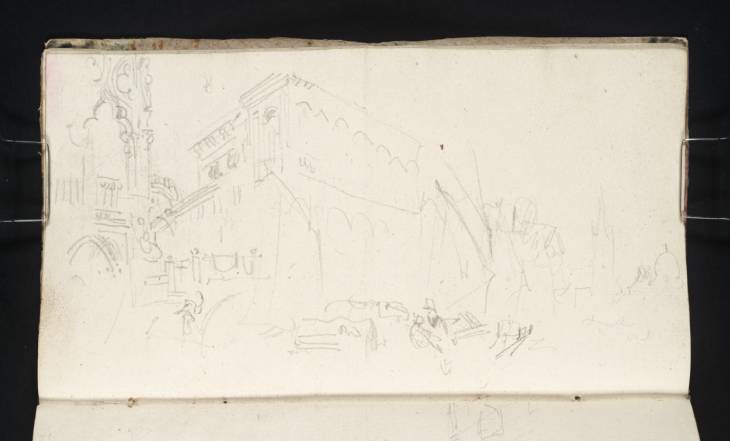Joseph Mallord William Turner The South-East Corner of the Palazzo Ducale (Doge's Palace), Venice, from the Molo, with the New Prisons across the Ponte della Paglia, and the Bridge of Sighs Beyond; San Giorgio Maggiore across the Bacino 1833
Image 1 of 2
-
 Joseph Mallord William Turner, The South-East Corner of the Palazzo Ducale (Doge's Palace), Venice, from the Molo, with the New Prisons across the Ponte della Paglia, and the Bridge of Sighs Beyond; San Giorgio Maggiore across the Bacino 1833
Joseph Mallord William Turner, The South-East Corner of the Palazzo Ducale (Doge's Palace), Venice, from the Molo, with the New Prisons across the Ponte della Paglia, and the Bridge of Sighs Beyond; San Giorgio Maggiore across the Bacino 1833 -
 Joseph Mallord William Turner, The South-East Corner of the Palazzo Ducale (Doge's Palace), Venice, from the Molo, with the New Prisons across the Ponte della Paglia, and the Bridge of Sighs Beyond; San Giorgio Maggiore across the Bacino 1833 (Enhanced image)Enhanced image
Joseph Mallord William Turner, The South-East Corner of the Palazzo Ducale (Doge's Palace), Venice, from the Molo, with the New Prisons across the Ponte della Paglia, and the Bridge of Sighs Beyond; San Giorgio Maggiore across the Bacino 1833 (Enhanced image)Enhanced image
Joseph Mallord William Turner,
The South-East Corner of the Palazzo Ducale (Doge's Palace), Venice, from the Molo, with the New Prisons across the Ponte della Paglia, and the Bridge of Sighs Beyond; San Giorgio Maggiore across the Bacino
1833
Joseph Mallord William Turner 1775–1851
Folio 5 Verso:
The South-East Corner of the Palazzo Ducale (Doge’s Palace), Venice, from the Molo, with the New Prisons across the Ponte della Paglia, and the Bridge of Sighs Beyond; San Giorgio Maggiore across the Bacino 1833
D31936
Turner Bequest CCCXIV 5
Turner Bequest CCCXIV 5
Pencil on white laid paper, 109 x 203 mm
Accepted by the nation as part of the Turner Bequest 1856
References
1909
A.J. Finberg, A Complete Inventory of the Drawings of the Turner Bequest, London 1909, vol.II, p.1012, CCCXIV 5, as ‘The Ducal Palace and Prison’.
1984
Hardy George, ‘Turner in Europe in 1833’, Turner Studies, vol.4, no.1, Summer 1984, p.13.
2003
Ian Warrell in Warrell, David Laven, Jan Morris and others, Turner and Venice, exhibition catalogue, Tate Britain, London 2003, pp.116, 263 note 39.
The Turner scholar C.F. Bell annotated Finberg’s 1909 Inventory entry (‘The Ducal Palace and Prison’): ‘Ponte della Paglia’.1 The page’s title was amended by Ian Warrell to ‘The New Prisons and the Ponte della Paglia, with the South-East Corner of the Doge’s Palace’ in 2003, in connection with his concurrent Turner and Venice exhibition at Tate Britain.2 The drawing was made with the page turned horizontally.
The view is from (or just off) the broad Molo quay, looking north to the south-east corner of the Palazzo Ducale (Doge’s Palace) on the left, focusing on the stonework of the ground-floor arch (with the ‘Drunkenness of Noah’ sculpture on the ‘Vine angle’ beside it only loosely indicated) and the tracery of the first bay above. Spanning the Rio del Palazzo in the foreground is the Ponte della Paglia, shown in partial detail, conserving time and also seemingly on account of a raised sail blocking part of the view on this occasion. The main façade of the New Prisons is shown with little detail beyond the alternating segmental and pointed pediment mouldings over the seven upper windows, and the corresponding run of round arches along the quay. The heavily articulated and rusticated side along the Rio del Palazzo is more developed, with a glimpse of the curved profile of the high-level Bridge of Sighs beyond the corner of the palace. Compare the view in the 1840 Rotterdam to Venice sketchbook (Tate D32437; Turner Bequest CCCXX 89), where the south front of the New Prisons is again given only selective attention.
The rest of the Riva degli Schiavoni waterfront recedes in steep perspective to the right beyond more sails and masts, with only the pediment of the Pietà church differentiated. Immediately to its right in the drawing, but in fact facing the palace a considerable way south across the waters of the Bacino and Canale di San Marco, is a rough outline of the familiar campanile and dome of San Giorgio Maggiore, no doubt from the same viewpoint. Near the bottom centre is a brief continuation upwards from the horizontal view of the Doge’s Palace and Piazzetta from a similar position on folio 6 recto opposite (D31938), showing the south-west corner of the palace.
Ian Warrell has linked the present sketch, along with folios 24 verso, 29 recto and 30 verso (D31973, D31982, D31985), to the oil painting of Venice, the Bridge of Sighs, exhibited at the Royal Academy in 1840 (Tate N00527),3 which shows the view directly down the side canal, notionally from some way out on the Bacino;4 see also folio 9 recto (D31943). For this sketchbook’s general sequence, including Hardy George’s broad overview,5 see its Introduction.
As listed in its overall technical notes, this is one of three leaves in this sketchbook with a blank recto and a drawing on the verso not distinguished as such by the customary ‘a’ suffix to its number in Finberg’s 1909 Inventory.6 When Tate accession numbers were assigned, the recto was initially designated D31936, with this side as D31937; the latter was subsequently cancelled, and the first number now applies to the present page. The otherwise blank recto is inscribed by C.F. Bell in black ink ‘5’ and stamped in black ‘CCCXIV – 5’ at the bottom right in sequence with adjacent leaves.
Matthew Imms
May 2019
How to cite
Matthew Imms, ‘The South-East Corner of the Palazzo Ducale (Doge’s Palace), Venice, from the Molo, with the New Prisons across the Ponte della Paglia, and the Bridge of Sighs Beyond; San Giorgio Maggiore across the Bacino 1833 by Joseph Mallord William Turner’, catalogue entry, May 2019, in David Blayney Brown (ed.), J.M.W. Turner: Sketchbooks, Drawings and Watercolours, Tate Research Publication, March 2023, https://www

